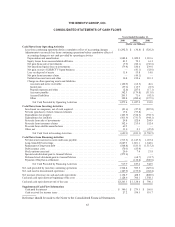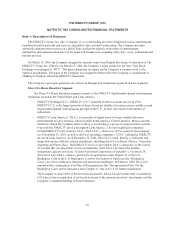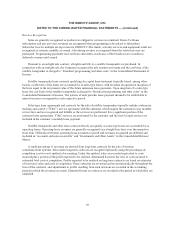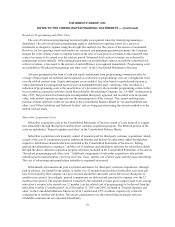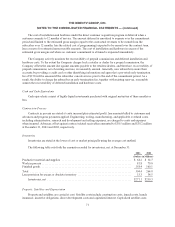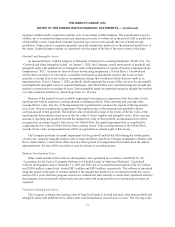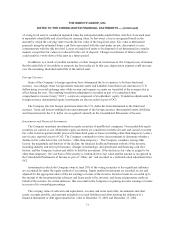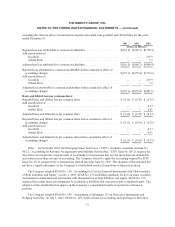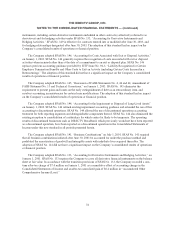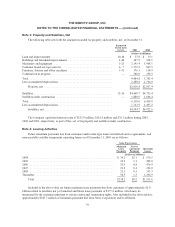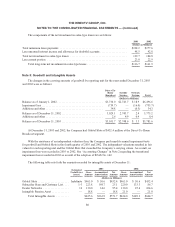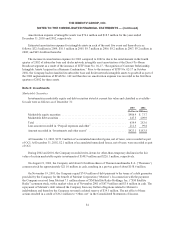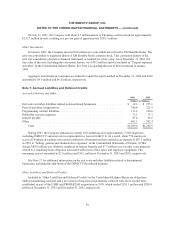DIRECTV 2003 Annual Report Download - page 80
Download and view the complete annual report
Please find page 80 of the 2003 DIRECTV annual report below. You can navigate through the pages in the report by either clicking on the pages listed below, or by using the keyword search tool below to find specific information within the annual report.THE DIRECTV GROUP, INC.
NOTES TO THE CONSOLIDATED FINANCIAL STATEMENTS — (continued)
of a long-lived asset is considered impaired when the anticipated undiscounted future cash flow from such asset
is separately identifiable and is less than its carrying value. In that event, a loss is recognized based on the
amount by which the carrying value exceeds the fair value of the long-lived asset. Fair value is determined
primarily using the estimated future cash flows associated with the asset under review, discounted at a rate
commensurate with the risk involved. Losses on long-lived assets to be disposed of are determined in a similar
manner, except that fair values are reduced for the cost of disposal. Changes in estimates of future cash flows
could result in a write-down of the asset in a future period.
In addition, as a result of satellite anomalies or other changes in circumstances, the Company may determine
that the useful life of its satellites or property has been reduced. In this case, depreciation expense could increase
over the remaining shortened useful life of the related asset.
Foreign Currency
Some of the Company’s foreign operations have determined the local currency to be their functional
currency. Accordingly, these foreign entities translate assets and liabilities from their local currencies to U.S.
dollars using year-end exchange rates while income and expense accounts are translated at the average rates in
effect during the year. The resulting translation adjustment is recorded as part of accumulated other
comprehensive income (loss) (“OCI”), a separate component of stockholders’ equity. Translation adjustments for
foreign currency denominated equity investments are also recorded as part of OCI.
The Company also has foreign operations where the U.S. dollar has been determined as the functional
currency. Gains and losses resulting from remeasurement of the foreign currency denominated assets, liabilities
and transactions into the U.S. dollar are recognized currently in the Consolidated Statements of Income.
Investments and Financial Instruments
The Company maintains investments in equity securities of unaffiliated companies. Non-marketable equity
securities are carried at cost. Marketable equity securities are considered available-for-sale and carried at current
fair value based on quoted market prices with unrealized gains or losses (excluding other-than-temporary losses),
net of taxes, reported as part of OCI. The Company continually reviews its investments to determine whether a
decline in fair value below the cost basis is “other-than-temporary.” The Company considers, among other
factors: the magnitude and duration of the decline; the financial health and business outlook of the investee,
including industry and sector performance, changes in technology, and operational and financing cash flow
factors; and the Company’s intent and ability to hold the investment. If the decline in fair value is judged to be
other-than-temporary, the cost basis of the security is written-down to fair value and the amount is recognized in
the Consolidated Statements of Income as part of “Other, net” and recorded as a reclassification adjustment from
OCI.
Investments in which the Company owns at least 20% of the voting securities or has significant influence
are accounted for under the equity method of accounting. Equity method investments are recorded at cost and
adjusted for the appropriate share of the net earnings or losses of the investee. Investee losses are recorded up to
the amount of the investment plus advances and loans made to the investee, and financial guarantees made on
behalf of the investee. In certain instances, this can result in the Company recognizing investee earnings or losses
in excess of its ownership percentage.
The carrying value of cash and cash equivalents, accounts and notes receivable, investments and other
assets, accounts payable, and amounts included in accrued liabilities and other meeting the definition of a
financial instrument or debt approximated fair value at December 31, 2003 and December 31, 2002.
73




